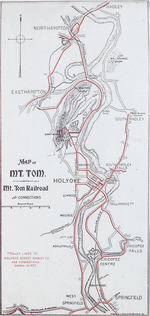Holyoke Street Railway
The Holyoke Street Railway (HSR) was an interurban streetcar and bus system operating in Holyoke, Massachusetts as well as surrounding communities with connections in Amherst, Belchertown, Chicopee, Easthampton, Granby, Northampton, Pelham, South Hadley, Sunderland, Westfield, and West Springfield. Throughout its history the railway system shaped the cultural institutions of Mount Tom, being operator of the mountain's famous summit houses, one of which hosted President McKinley, the Mount Tom Railroad, and the trolley park at the opposite end of this funicular line, Mountain Park.
 | |||||||||||||||||||||||||||||||||||||||||||||||||||||||||||||||||||||||||||||||||||||||||||||||||||||||||||||||||||||||||||||||||||||||||||||||||||||||||||||||||||||||||||||||||||||||||||||||||||||||||||||||||||||||||||||||||||||||||||||||||||||||||||||||||||||||||||||||||||||||||||||||||||
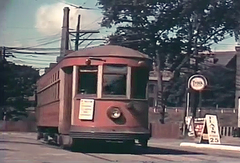 | |||||||||||||||||||||||||||||||||||||||||||||||||||||||||||||||||||||||||||||||||||||||||||||||||||||||||||||||||||||||||||||||||||||||||||||||||||||||||||||||||||||||||||||||||||||||||||||||||||||||||||||||||||||||||||||||||||||||||||||||||||||||||||||||||||||||||||||||||||||||||||||||||||
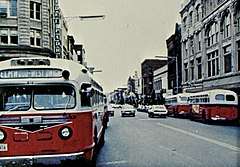 The Holyoke Street Railway at one time provided both interurban rail (top, 1937) and bus service (bottom, 1973); the latter would replace the former however both remained in tandem service from 1921 to 1937. | |||||||||||||||||||||||||||||||||||||||||||||||||||||||||||||||||||||||||||||||||||||||||||||||||||||||||||||||||||||||||||||||||||||||||||||||||||||||||||||||||||||||||||||||||||||||||||||||||||||||||||||||||||||||||||||||||||||||||||||||||||||||||||||||||||||||||||||||||||||||||||||||||||
| Overview | |||||||||||||||||||||||||||||||||||||||||||||||||||||||||||||||||||||||||||||||||||||||||||||||||||||||||||||||||||||||||||||||||||||||||||||||||||||||||||||||||||||||||||||||||||||||||||||||||||||||||||||||||||||||||||||||||||||||||||||||||||||||||||||||||||||||||||||||||||||||||||||||||||
|---|---|---|---|---|---|---|---|---|---|---|---|---|---|---|---|---|---|---|---|---|---|---|---|---|---|---|---|---|---|---|---|---|---|---|---|---|---|---|---|---|---|---|---|---|---|---|---|---|---|---|---|---|---|---|---|---|---|---|---|---|---|---|---|---|---|---|---|---|---|---|---|---|---|---|---|---|---|---|---|---|---|---|---|---|---|---|---|---|---|---|---|---|---|---|---|---|---|---|---|---|---|---|---|---|---|---|---|---|---|---|---|---|---|---|---|---|---|---|---|---|---|---|---|---|---|---|---|---|---|---|---|---|---|---|---|---|---|---|---|---|---|---|---|---|---|---|---|---|---|---|---|---|---|---|---|---|---|---|---|---|---|---|---|---|---|---|---|---|---|---|---|---|---|---|---|---|---|---|---|---|---|---|---|---|---|---|---|---|---|---|---|---|---|---|---|---|---|---|---|---|---|---|---|---|---|---|---|---|---|---|---|---|---|---|---|---|---|---|---|---|---|---|---|---|---|---|---|---|---|---|---|---|---|---|---|---|---|---|---|---|---|---|---|---|---|---|---|---|---|---|---|---|---|---|---|---|---|---|---|---|---|---|---|---|---|---|---|---|---|---|---|---|---|---|---|---|---|---|---|---|---|---|---|---|---|---|---|---|---|---|---|
| Owner | Holyoke Street Rwy. Co. | ||||||||||||||||||||||||||||||||||||||||||||||||||||||||||||||||||||||||||||||||||||||||||||||||||||||||||||||||||||||||||||||||||||||||||||||||||||||||||||||||||||||||||||||||||||||||||||||||||||||||||||||||||||||||||||||||||||||||||||||||||||||||||||||||||||||||||||||||||||||||||||||||||
| Area served |
| ||||||||||||||||||||||||||||||||||||||||||||||||||||||||||||||||||||||||||||||||||||||||||||||||||||||||||||||||||||||||||||||||||||||||||||||||||||||||||||||||||||||||||||||||||||||||||||||||||||||||||||||||||||||||||||||||||||||||||||||||||||||||||||||||||||||||||||||||||||||||||||||||||
| Transit type | Light rail
| ||||||||||||||||||||||||||||||||||||||||||||||||||||||||||||||||||||||||||||||||||||||||||||||||||||||||||||||||||||||||||||||||||||||||||||||||||||||||||||||||||||||||||||||||||||||||||||||||||||||||||||||||||||||||||||||||||||||||||||||||||||||||||||||||||||||||||||||||||||||||||||||||||
| Chief executive | Louis D. Pellisier, Jr. (1955–1991) | ||||||||||||||||||||||||||||||||||||||||||||||||||||||||||||||||||||||||||||||||||||||||||||||||||||||||||||||||||||||||||||||||||||||||||||||||||||||||||||||||||||||||||||||||||||||||||||||||||||||||||||||||||||||||||||||||||||||||||||||||||||||||||||||||||||||||||||||||||||||||||||||||||
| Headquarters | 63 N Canal Street Holyoke, MA 01040-5836 | ||||||||||||||||||||||||||||||||||||||||||||||||||||||||||||||||||||||||||||||||||||||||||||||||||||||||||||||||||||||||||||||||||||||||||||||||||||||||||||||||||||||||||||||||||||||||||||||||||||||||||||||||||||||||||||||||||||||||||||||||||||||||||||||||||||||||||||||||||||||||||||||||||
| Operation | |||||||||||||||||||||||||||||||||||||||||||||||||||||||||||||||||||||||||||||||||||||||||||||||||||||||||||||||||||||||||||||||||||||||||||||||||||||||||||||||||||||||||||||||||||||||||||||||||||||||||||||||||||||||||||||||||||||||||||||||||||||||||||||||||||||||||||||||||||||||||||||||||||
| Began operation | September 24, 1884[3] August 7, 1891 (electrified)[4] 1921(bus)[1] | ||||||||||||||||||||||||||||||||||||||||||||||||||||||||||||||||||||||||||||||||||||||||||||||||||||||||||||||||||||||||||||||||||||||||||||||||||||||||||||||||||||||||||||||||||||||||||||||||||||||||||||||||||||||||||||||||||||||||||||||||||||||||||||||||||||||||||||||||||||||||||||||||||
| Ended operation | September 6, 1937 (rail)[5] July 1, 1987 (bus)[2] March 13, 1991 (dissolved)[6] | ||||||||||||||||||||||||||||||||||||||||||||||||||||||||||||||||||||||||||||||||||||||||||||||||||||||||||||||||||||||||||||||||||||||||||||||||||||||||||||||||||||||||||||||||||||||||||||||||||||||||||||||||||||||||||||||||||||||||||||||||||||||||||||||||||||||||||||||||||||||||||||||||||
| Technical | |||||||||||||||||||||||||||||||||||||||||||||||||||||||||||||||||||||||||||||||||||||||||||||||||||||||||||||||||||||||||||||||||||||||||||||||||||||||||||||||||||||||||||||||||||||||||||||||||||||||||||||||||||||||||||||||||||||||||||||||||||||||||||||||||||||||||||||||||||||||||||||||||||
| Track gauge | 4 ft 8 1⁄2 in (1,435 mm) standard gauge[7]:907 | ||||||||||||||||||||||||||||||||||||||||||||||||||||||||||||||||||||||||||||||||||||||||||||||||||||||||||||||||||||||||||||||||||||||||||||||||||||||||||||||||||||||||||||||||||||||||||||||||||||||||||||||||||||||||||||||||||||||||||||||||||||||||||||||||||||||||||||||||||||||||||||||||||
| |||||||||||||||||||||||||||||||||||||||||||||||||||||||||||||||||||||||||||||||||||||||||||||||||||||||||||||||||||||||||||||||||||||||||||||||||||||||||||||||||||||||||||||||||||||||||||||||||||||||||||||||||||||||||||||||||||||||||||||||||||||||||||||||||||||||||||||||||||||||||||||||||||
In the history of American railroad engineering, the system was the first in the United States to make use of exothermic welding, better known as thermite welding, to lay track for regular use.[8][9][10] Railway engineer George E. Pellissier would not only be the first in the country to implement this now-standard operating procedure, but would further develop Hans Goldschmidt's welding process for the street railway, subsequently serving as an engineer and superintendent for the inventor's Goldschmidt Thermite Company before returning to Holyoke as an assistant general manager.[10][11][12]
Operated by the Holyoke Street Railway Company, abbreviated on livery as the Hly. St. Ry. Co., the streetcar system began operation on September 24, 1884, consolidated with the Amherst and Sunderland Street Railway in 1907, and ceased operations as a streetcar operator in 1937.[5] Regular bus operations began in 1921, and soon after the incorporation of the Pioneer Valley Transit Authority in 1977, the company began serving as a contract operator. This service continued until 1987, when a dispute between labor and management led regular bus service to an abrupt end, with would-be passengers still waiting at stops, on July 1, 1987.[2][1]:611 After four years of inactivity and with a municipal school bus contract failing to pass negotiations, the company liquidated its assets and had dissolved by 1991.[3][6]
Today their former headquarters serves as the main facilities of the Holyoke Department of Public Works, now known as the Pellisier Building, for the family which owned and managed the system in its final decades.[13] A second car barn of the Amherst and Sunderland Street Railway division functions as facilities for the town of Amherst's own Department of Public Works.[14]
Rail
Founding and early years

The Holyoke Street Railway Company held its first meeting on February 12, 1884,[5] with a charter granted by the Office of Secretary of the Commonwealth Henry B. Pierce on June 11, 1884.[15] According to the company's articles of association, it began with capital of $25,000 (≈$692,000 in 2017 USD) with 250 shares of $100 each issued, and was authorized to operate as a horsecar rail system in South Hadley and Holyoke. The company's first president was William A. Chase, and its first board of directors included two members who would later become mayors of Holyoke, Franklin P. Goodall and George H. Smith.[16]
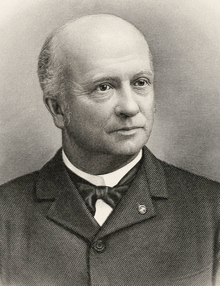
The system rapidly expanded its service capacity; in 1884, the system had 2 cars and 5 horses operating a line between Main Street in Holyoke and South Hadley Falls, by 1886 this had expanded to 3 other routes in Holyoke and the livery totaled at 15 cars and 56 horses.[5] At the time it was commonplace for patrons to keep lumps or cubes of sugar in their pockets for often ornery horses.[17] In its earliest years it met some resistance from Hampshire County commissioners and South Hadley selectmen, threatening to withdraw from South Hadley Falls in 1886 due to policies related to taxation and maintenance of roads and a former bridge connecting Holyoke across the Connecticut River.[18] The following year, it was proposed the company stop every other car on the South Hadley route on the Holyoke side of where the Vietnam Memorial Bridge stands today, to halve taxes paid for use of the bridge there at that time.[19] Public opinion on the South Hadley side of the river remained largely in favor of the company, however one writer for The Republican compared the ordeal to "child's play" due to lack of compromise by either.[20] Some consensus was eventually reached during the construction of the bridge's successor, the Hadley-Holyoke Bridge by engineer Edward S. Shaw, as the railway company's lawyer would work with Hampshire and Hampden county commissioners to negotiate the bridge's width and location of the railway tracks.[21]
In 1887, William S. Loomis, a former partner in the Holyoke Transcript-Telegram, approached the railway's board of directors proposing that their line from City Hall and Maple Street be extended further into Elmwood. Loomis had previously purchased a large tract of land there which he planned to develop into a streetcar suburb. His calls for expansion were rejected however by the railway company, but ultimately working with connections from his time as a newspaper magnate, he would buy a controlling share in the company. Upon purchasing this stock, Loomis began working on the laying out of additional tracks along with roads on his own land, the former Horace Brown Farm which would become the blocks around modern-day Elmwood Avenue, as well as Laurel Street/Brown Avenue across Northampton Street. During his time with the railway Loomis would serve as treasurer as well as general manager of the company, and is generally credited as a key figure in the expansion of the railway system to the two other neighborhoods, Oakdale and Springdale.[22][23][24]
Electrification and expansion

.png)
The railway's first electric car ran on the South Hadley Falls line at about 2pm on August 8, 1891, and by the end of that year all routes had been electrified. The very first run however proved to not be a resounding success as aside from Loomis and the board of directors, no passengers climbed aboard on the maiden run of an electric car; it was not until the return trip back over the bridge from South Hadley that one Jesse L. Bliss became the new system's first passenger. Bliss himself would go on to try to become a driver of the cars, however reportedly jumped one of the trolleys off the tracks on his own first run.[17][25]
The electrification of old horse trams came within less than a decade for the Holyoke Street Railway and in Massachusetts as a whole. When the railway's first electric cars appeared in 1891, at the time about a third of all street railway lines in Massachusetts had electric overhead systems. However by the turn of the century not only were these cars commonplace in the Holyoke system, they comprised more than 99% of such streetcar lines in the Commonwealth.[26]
Another feature that typified railways in the late nineteenth and early twentieth centuries was trolley parks; in the years immediately after the electrification of the system, Loomis purchased a large lot on the southeastern side of Mount Tom and in 1894 purchased a post-and-beam stage for performers there. In 1895 the railway was extended to this site, and by 1897 the area was officially chartered at Mountain Park.
In his 1908 report to Mayor Nathan P. Avery, landscape architect and planner Frederick Law Olmsted Jr. urged the city to work to more closely align its planning with the development of the street railway in a working relationship, saying a liaison or authority ought to be established in determining future extensions and improvements in the electric railway lines operating in the city, stressing it would yield some of the most economical growth of housing capacity in tandem with the grid system.[27]
Pioneering thermite rail welding
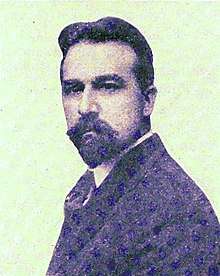
As a transportation system, the railway also held at least one unprecedented piece of technology prior to its numerous competitors in the early 20th century- thermite welding. During the 1890s in Germany, Hans Goldschmidt developed the modern process for exothermic welding for railways. This process, now an international standard in railway construction, was first used commercially in tram lines in Essen, Germany in 1899. Over the next several years other cities including Leeds and Singapore would adopt this construction method,[28] and in 1904 its inventor would open the Goldschmidt Thermit Company offices in New York City.[29] While development of this process continued, an engineering student at Worcester Polytechnic Institute, George E. Pellissier (1878-1961)[30][31], followed Goldschmidt's work closely and approached the Holyoke Street Railway proposing that they use the new thermite process for their own lines. Soon after the railway ordered 160 joints to be placed on an approximately mile-long tract of rail on Main Street, and on August 8, 1904 Holyoke became the first rail line in the United States to lay track with the process.[9] That same year Hartford would join the ranks as the second in country.[32]

While Hartford would be met with some issues due to what was later described as a rushed installation, the Holyoke installation served as a proof-of-concept for the advantages of the method. With thermite welding, a small crew of unskilled laborers with no prior knowledge of welding or specialty metalwork could be sent out with a crucible, pre-made molds, and a set amount of thermite. For railway companies the new technique would lead to a more reliable and inexpensive method of laying down new tracks that would make future system expansion more practical than bolted or welded separate joint techniques used up to that time.[32][29]
This represented the beginning of Pellissier's career with the railway company, as he would obtain a full-time engineer position upon graduation and went on to present his work to the American Street and Interurban Railway Association in 1905.[32][33] The Holyoke engineer would not only serve as merely Goldschmidt's first American customer, but rather Pellissier would go on to work for the inventor's American company in New York, designing their Jersey City welding plant and also contributing improvements to the thermite installation process.[34] In 1910 the Holyoke Street Railway, which had since used thermite for regular work, served as an urban laboratory for Pellissier's refinements on the process for the Goldschmidt Company, during which he tested a new technique for whole-rail welds, an improvement contributing to the development of continuous welded rail.[10]
Extended system
Amherst and Sunderland Street Railway
 | ||||||||||||||||||||||||||||||||||||||||||||||||||||||||||||||||||||||||||||||||||||||||||||||||||||||||||||||||||||||||||||||||||||
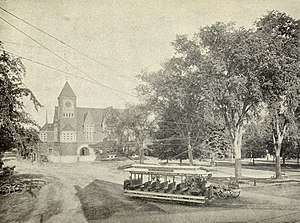 An Amherst & Sunderland streetcar passes Town Hall in Amherst Center, 1903 | ||||||||||||||||||||||||||||||||||||||||||||||||||||||||||||||||||||||||||||||||||||||||||||||||||||||||||||||||||||||||||||||||||||
| Overview | ||||||||||||||||||||||||||||||||||||||||||||||||||||||||||||||||||||||||||||||||||||||||||||||||||||||||||||||||||||||||||||||||||||
|---|---|---|---|---|---|---|---|---|---|---|---|---|---|---|---|---|---|---|---|---|---|---|---|---|---|---|---|---|---|---|---|---|---|---|---|---|---|---|---|---|---|---|---|---|---|---|---|---|---|---|---|---|---|---|---|---|---|---|---|---|---|---|---|---|---|---|---|---|---|---|---|---|---|---|---|---|---|---|---|---|---|---|---|---|---|---|---|---|---|---|---|---|---|---|---|---|---|---|---|---|---|---|---|---|---|---|---|---|---|---|---|---|---|---|---|---|---|---|---|---|---|---|---|---|---|---|---|---|---|---|---|---|
| Area served | ||||||||||||||||||||||||||||||||||||||||||||||||||||||||||||||||||||||||||||||||||||||||||||||||||||||||||||||||||||||||||||||||||||
| Operation | ||||||||||||||||||||||||||||||||||||||||||||||||||||||||||||||||||||||||||||||||||||||||||||||||||||||||||||||||||||||||||||||||||||
| Began operation | June 16, 1897[35] July 30, 1907 (consolidation)[36] | |||||||||||||||||||||||||||||||||||||||||||||||||||||||||||||||||||||||||||||||||||||||||||||||||||||||||||||||||||||||||||||||||||
| Ended operation | 1932 (rail; name dropped for buses)[1]:630 | |||||||||||||||||||||||||||||||||||||||||||||||||||||||||||||||||||||||||||||||||||||||||||||||||||||||||||||||||||||||||||||||||||
| Technical | ||||||||||||||||||||||||||||||||||||||||||||||||||||||||||||||||||||||||||||||||||||||||||||||||||||||||||||||||||||||||||||||||||||
| Track gauge | 4 ft 8 1⁄2 in (1,435 mm) standard gauge[7]:900 | |||||||||||||||||||||||||||||||||||||||||||||||||||||||||||||||||||||||||||||||||||||||||||||||||||||||||||||||||||||||||||||||||||
| ||||||||||||||||||||||||||||||||||||||||||||||||||||||||||||||||||||||||||||||||||||||||||||||||||||||||||||||||||||||||||||||||||||
%2C_Amherst%2C_Massachusetts.jpg)
The Amherst and Sunderland Street Railway was an interurban streetcar system that operated in Amherst, Sunderland, Pelham, Granby, and South Hadley, Massachusetts. From 1897 until 1932, trolleys operated between Sunderland, the Massachusetts Agricultural College (now UMass Amherst), and connected with the Holyoke Street Railway's system at "The Notch" after 1902. This rail line, providing freight and passenger service,[37] was built by the short-lived Hampshire Street Railway specifically to connect the other two systems; the Hampshire Street Railway would lease the line to the Holyoke railway in 1905, which ultimately consolidated with it, along with Amherst & Sunderland, in 1907. After the merger the name was kept as a legacy and lines to the north of the Holyoke Range were referred to as the Amherst and Sunderland Division of the Holyoke Street Railway. While the HSR would continue operations in Amherst as a bus carrier, after trolley service ceased in 1932 the A&S name was dropped altogether.[1]
The company was initially chartered on February 27, 1896, but was beset by legal troubles in its initial formation. Among these setbacks was the sale of shares under the name the "Amherst Street Railway Company", which legally did not exist, prompting the board to have to take up entirely new shares from the same parties that they had first sold them to.[38] This issue had apparently arisen from an early board meeting during which a stockholder from Sunderland moved to append the town name to the railway company's, however none of the members had new paperwork printed to reflect this.[39] This problem was further complicated when then-president of the board, Levi Stockbridge, revealed the state railroad commissioners refused to recognize the company, as its charter had been accepted in the minutes of a meeting called by a single board member, rather than the entirety of the charter members.[40] Despite predictions by some that this was the end of the enterprise, Stockbridge urged that if the group did not organize to build the street railway, there were several other syndicates which would; by the end of their next meeting the group was able to recollect all necessary shares.[39]
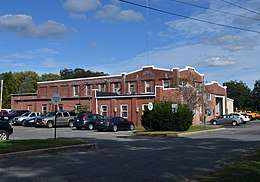
Following an extended period of discussion over the specific location of the tracks, work commenced in the laying of line in April of 1897, and by June of that year the first trolleys were operational.[35] While Stockbridge remains notable among founding figures of the street railway, his role as president of the company was limited to its first year, a greater credit was due to Walter D. Cowles, a member of the board and subsequent president of the company, whose family stored the streetcars in car barn facilities on the grounds of their lumber business in the railways earliest years.[42][43] In 1897 the railway began to see competition from the Northampton and Amherst Railway, later known as the Connecticut Valley Street Railway,[1]:632, as it connected Northampton to Amherst, through Hadley. Despite outcry from the Amherst & Sunderland Street Railway and its interests, by the end of 1897 the competitor had been given access and some consideration was given to franchise.[44] In response to this, the railway would attempt to expand its own holdings in Hadley, building a new line through Mill Valley to the Hadley border in the following year.[45]
The railway's ties with the Holyoke Street Railway began in 1902 when the stockholders and directors voted to increase the capital stock of the company to construct a line across the Notch in the Holyoke Range and connect with the Hampshire Street Railway system at the Granby town line.[46] The Hampshire Street Railway, organized that same year, served as a collaboration of the interests of the Amherst and Holyoke railways, with Walter Cowls and William Loomis elected as sitting directors in the following year at an annual meeting at the Holyoke company's offices.[47] In the following year the railway began advertising jointly with the Holyoke Street Railway as the best way to reach "The Famous Amherst 'Notch'",[48] and by 1905 the entirety of the system was leased to Holyoke.[1]:634
The loose association between the Amherst and Sunderland system and Holyoke's became official when in 1907 the company moved to buy all stock of the Amherst company, consolidating it with the acquired Hampshire system to create the Amherst and Sunderland Division of the Holyoke Street Railway. In the next several years the HSR would further develop the Orient Springs stop in West Pelham as a picnic ground,[49] as well as construct new infrastructure such as permanent stops, the last of which stood at UMass Amherst from 1911 until 2012 when it was razed by a contractor.[50] The car barn on the Cowls property was maintained until the North Amherst route switched to bus service in 1928.[43] The only extant structure related to the Amherst division today is the former South Amherst Car Barn which first entered service in 1917. Increasing competition from buses and cars would lead this structure to serve for less than 15 years, with all Amherst & Sunderland rail service ceasing in 1932.[1]:630 The facility was sold to the town government in 1934, and has been used as the Amherst Department of Public Works offices and garage since that time.[14] In July 2019 it was announced that the trolley barn would be razed for a modern fire department headquarters.[51]
Mount Tom Railroad
 | |||
 | |||
| Overview | |||
|---|---|---|---|
| Area served | Mount Tom, Holyoke, Massachusetts | ||
| Transit type | Funicular | ||
| Operation | |||
| Began operation | June 17, 1897[52] | ||
| Ended operation | 1938 | ||
| Technical | |||
| Track gauge | 4 ft 8 1⁄2 in (1,435 mm) standard gauge[53]:10 | ||
| |||
The Mount Tom Railroad, also known as the Mount Tom Railway, was a funicular mountain railway on the northeast slope of Mount Tom in Holyoke, Massachusetts which was operated by the Holyoke Street Railway from 1897 until 1938. Built in 1897, the railway quickly gained national fame when it was visited by President William McKinley who remarked upon the beauty of the mountainside. It was closely identified with the Summit Houses which adorned the mountaintop with the most ornate first two designed by local architect James A. Clough.[54][55][56] At the foot of the railway sat Mountain Park, which connected the cable railway with the Holyoke Street Railway system.
For several years William Loomis and the rest of the board had pursued the idea of a mountain railway to connect the summit to their system, with notices published as far back as 1893, soon after the lines had been electrified.[57] By June 6, 1896,[58] the Mount Tom Railroad Company had been incorporated, with Loomis serving as president of both it as a separate entity and the HSR as a whole. The location of the railway, now a service road and paved trail, was determined early in planning as ideally running up the side of the mountain diagonally to follow the contours of a ravine, thus minimizing needed blasting and grading work. The rails construction and design was said to be based on the Lookout Mountain Incline Railway's, having a single track with one passing loop between the funicular's alternating cars.[59]
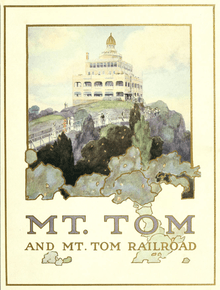
Construction began in early 1897 under the Charles F. Parker Company of New York City, and by June, the Mount Tom Railroad Company had officiated a 25 year operating lease with the Holyoke Street Railway.[7] The inaugural ride took place on June 17, 1897, with a number of city officials, railway employees, and officials of the Wason Manufacturing Company being the first passengers.[60] The railway briefly rose to national fame when President McKinley and First Lady Ida Saxton rode to the summit house on June 20, 1899.[61]
At one point toward the end of the railroad's existence, there was some discussion of using it to pull skiers up the mountainside. This planned ski resort would not ultimately materialize however and it would not be until 1962 that the Mount Tom Ski Area would open.[62][63] Following a period of decline and financial difficulties by its parent company, the Mount Tom Railroad cable railway was sold and dismantled in 1938.[64]
Legacy
Today few vestiges remain of the former streetcar or bus systems, and the railway is best remembered for its Mount Tom Summit House and inclined railway, which was visited by President William McKinley in 1899. Following a series of fires and the Great Depression, the third and final summit house was disassembled after a vandalism incident in 1938.[65]
While routes have changed in the decades since the railway's closure, the PVTA continues to provide bus service in Holyoke as well as all other municipalities previously covered by the former carrier's services.[66] Due to several recessions in the 1980s, the railway's former amusement park Mountain Park shuttered the same year as buses ceased, in 1987. This year coincides with the Railway Company's closure however the two were unaffiliated by that time; Louis Pellissier Sr. had sold the amusement park to the Collins family of Lincoln Park in 1952, they assumed operations the following year until its closure.[67][68]
.jpg)
Of the original trolley stops, virtually all had been replaced by modern plexiglass bus stops by the time of the company's demise; the one exception had been a simple brick and glass structure built by the company for its Amherst and Sunderland line in 1911. This stop remained entirely intact and was used by the PVTA until it was destroyed by a contractor without university authorization in 2012; the university did not rebuild the 8-column waiting station, citing costs and the area's "modern use for today’s students".[50]
During the motorization period replacing the interurban system with bus lines, the company sold its Amherst and Sunderland Branch car barn in 1934, only 17 years after its construction, to the Town of Amherst's Dept. of Public Works. While several additions have been added over the years, the municipality has kept certain attention to detail, including keeping remaining tracks in place within the building. In recent years consideration has been given to a more modern facility but as of 2018, the car barn was still used by the town government.[14] In 2019 it was announced that the town intends to raze the car barn and replace it with a new fire department headquarters.[41] An homage to the Amherst & Sunderland lines history can also be found in the "Trolley Barn" development in North Amherst; while redeveloped in proximity to the line the building, done in the style of a car barn, was built in 2014.[69]

Borrowing from the precedent set by Amherst for its car barn, the City of Holyoke placed a request for proposal for a feasibility study in July 1988 for re-purposing the company's offices and central garage on Canal St, and assumed ownership of the building on December 21, 1988.[70][71] The car barn and offices, designed by the Samuel M. Green Company and built in 1914 by Casper Ranger Construction,[72] has since been rechristened the Pellisier Building for its previous owners, and converted into Holyoke's Department of Public Works headquarters, maintenance shop, and waste transfer station.[13]
No complete Holyoke Street Railway tram is known to exist today, however the Shore Line Trolley Museum's "Preserved North American Electric Cars Roster" (PNAECR) survey states the wooden cabin for one such car remains in Holyoke in the private collection of James Curran at The Wherehouse banquet hall.[73] Additionally four of the railway's Wason open-air cars were sold and repainted for the Blue Hill Street Railway of Canton in 1909, however fate of that livery remains unknown.[74]
See also
- Pioneer Valley Transit Authority (PVTA), contemporary transit provider
- Shelburne Falls Trolley Museum, local transit museum of Shelburne Falls and Colrain Street Railway
- Wason Manufacturing Company, former Springfield-based manufacturer of rail livery for the HSR
Notes
- Adapted from– "Zone Fares Successful in Holyoke". Electric Railway Journal. New York: McGraw Publishing Company. April 10, 1920. p. 750.; this map is not exhaustive and does not include all stops, the year 1920 is shown here as this was the last operating year the system was entirely rail-based; bus routes varied considerably and included additional stops not otherwise indicated here
References
- Wright, Henry Andrew (1949). The Story of Western Massachusetts. II. New York: Lewis Historical Publishing Company, Inc.
- "PVTA blasts bus lockout in Holyoke". Springfield Union-News. Springfield, Mass. July 2, 1987. p. 4.
- "Holyoke's Fine Trolly System; Its Expansion From a Two-Mile Horse Car Line in 1884 to Its Present Great Proportions". Springfield, Mass. September 2, 1923. p. 37.
- "Holyoke". Springfield Republican. Springfield, Mass. August 8, 1891. p. 6.
The first electric car was run over the road yesterday afternoon about 2 o'clock and it ran very well. The car was run the whole length of the line and people gathered on the street corners to watch its progress. Superintendent Loomis and some of the directors occupied front seats and smiled their approval. The horses along the line did not seem to mind the cars much
- "1880s-Chariots of Change". Chariots of Change - Digital Exhibit. Wistariahurst. 2013. Archived from the original on January 13, 2013.
- [Query- "Holyoke Street Railway Company"], Massachusetts Corp. Card Search, Corporation Cards of the Commonwealth of Massachusetts, Secretary of the Commonwealth
- Poor, H. V.; Poor, H. W. (1901). "Street Railways in Massachusetts". Poor's Manual of Railroads. XXXIII. New York: American Banknote Company.
- "Worcester Polytechnic". Springfield Republican. Springfield, Mass. January 30, 1905. p. 9.
The speaker described the work of rail welding on the Holyoke street railway lines, this road being the first road in the United States to make use of thermit welded jounts.
- "Thermit Rail Welding in Holyoke". Street Railway Journal. New York: McGraw Publishing Company. XXV (7): 317–318. February 18, 1905.
G. E. Pellissier, civil engineer of the Holyoke Street Railway Company, presented on Jan. 27 a paper before the Civil Engineers' Society of Worcester Polytechnic Institute on thermit [sic] welding...When the thermit process was introduced in the United States the Holyoke Street Railway Company decided to try it on a mile of track which was about to be reconstructed, and accordingly an order for 160 joints was placed with the Goldschmidt Thermit Company...The welding was commenced on Aug. 8, 1904...The work...was the first piece of track in the United States laid with thermit joints
- Pellissier, George E. (December 24, 1910). "Welding Entire Rail Sections at Holyoke, Mass". Electric Railway Journal. New York: McGraw Publishing Company. XXXVI (26): 1245–1246.
- "Personal Mention–George E. Pellissier". Electric Railway Journal. New York: McGraw Publishing Company: 743. October 20, 1917.
From 1906 until 1912 he was engineer and superintendent for the Goldschmidt Thermit Company, New York, N. Y., engaged in developing the Thermit process particularly as applied to electric railways
- For examples of role in Goldschmidt Thermit Company see Pellissier, George E. (March 1908). "Blow-Holes in Thermit Welds—Their Cause and Prevention". Reactions: A Quarterly Publication Devoted to the Science of Aluminothermics. New York: Goldschmidt Thermit Company. pp. 28–29.
- "New Shops for Thermit Welding; Informal Opening by a Delegation from the American Society of Mechanical Engineers". Reactions: A Quarterly Publication Devoted to the Science of Aluminothermics. New York: Goldschmidt Thermit Company. January 1909. pp. 5–10.
The plans for the building were prepared by G. E. Pellissier, Engineer of the company
- "New Shops for Thermit Welding; Informal Opening by a Delegation from the American Society of Mechanical Engineers". Reactions: A Quarterly Publication Devoted to the Science of Aluminothermics. New York: Goldschmidt Thermit Company. January 1909. pp. 5–10.
- Indoor Air Quality Assessment: Holyoke DPW, Pellisier Building (PDF) (Report). Massachusetts Dept. of Public Health. August 2016. Archived from the original (PDF) on September 18, 2018.
- Merzbach, Scott (February 2015). "Amherst commissions study of Department of Public Works headquarters, future needs". Archived from the original on September 18, 2018.
- Peirce, Henry B. (1885). "List of Street Railway Companies". Abstract of the Certificates of Corporations Organzied under the General Laws of Massachusetts. Boston: Wright & Potter Printing Co., State Printers. p. 22.
- "Report of the Holyoke Street Railway Company for the Year Ending September 30, 1884". Sixteenth Annual Report of the Board of Railroad Commissioners. Boston: Wright & Potter Printing Co., State Printers. January 1885. p. 322.
- Stadnicki, Anne (June 20, 1974). "You've Come a Long Way! Nickel Fare Fares Well". Springfield Union. p. 25.
- "The Street Railway Company Decide to Withdraw from South Hadley Falls". Springfield Republican. Springfield, Mass. October 6, 1886. p. 6.
The directors of the Holyoke street railway company met yesterday forenoon and after discussing the recent decision of the county commissioners decided to withdraw from the other side of the river as soon as their lease expires, which will be some time next summer
- "Street Railway Possibilities". Springfield Republican. Springfield, Mass. August 17, 1887. p. 5.
- "The Street Railway Trouble". Springfield Republican. Springfield, Mass. November 24, 1887. p. 6.
- "County Commissioners' Hearing". Springfield Republican. Springfield, Mass. July 7, 1888. p. 6.
- Cutter, William Richard; Crane, Ellery Bicknell; Gardner, Eugene C.; Read, Charles French; Ballard, Harland Hoge; Rantoul, Robert Samuel; Lockwood, John H.; Dyer, E. Alden (1916). Encyclopedia of Massachusetts, Biographical–Genealogical. VI. Boston: The American Historical Society, Inc. pp. 7–9.
- Richards Standard Atlas of the City of Holyoke, Massachusetts. Springfield, Mass.: Richards Map Company. 1911.
- Allyn, George H. (1912). Thirtieth Anniversary Sketch, Holyoke Daily Transcript, 1882–1912. The Transcript Publishing Co. p. 43. OCLC 24571746.
- "Holyoke". Springfield Republican. Springfield, Mass. August 8, 1891. p. 6.
The first electric car was run over the road yesterday afternoon about 2 o'clock and it ran very well. The car was run the whole length of the line and people gathered on the street corners to watch its progress. Superintendent Loomis and some of the directors occupied front seats and smiled their approval. The horses along the line did not seem to mind the cars much
- Mason, Edward S. (1932). The Street Railway Industry in Massachusetts; The Rise and Decline of an Industry. Cambridge, Mass.: Harvard University Press. OCLC 877341748.
- Olmsted Jr., Frederick Law (1908). Preliminary Report of Frederick L. Olmsted, Jr. Relative to Beautifying the City of Holyoke. Holyoke, Mass.: M. J. Doyle Printing Company.
- Pellissier, George E. (1905). "Thermit Rail Joints". The Journal of the Worcester Polytechnic Institute. Worcester Polytechnic Institute. VIII: 304–321.
- Lionsdale, C. P. "Thermite rail welding: history, process developments, current practices and outlook for the 21st century" (PDF). Proceedings of the AREMA 1999 Annual Conferences. Conrail Technical Services Laboratory. Retrieved April 5, 2013.
- Stephan Kallee: George E. Pellissier. The first American to use Thermite welding commercially. Published on 1 December 2018. Retrieved on 1 December 2018.
- George Edward Pellissier. On: Find a Grave. Retrieved on 1 December 2018.
- "In and About Springfield; Continuous Street Car Rail, Welding Tried at Holyoke". Springfield Republican. Springfield, Mass. August 20, 1905. p. 6.
- Report of the Third Annual Convention of the American Railway Mechanical and Electrical Association [American Street and Interurban Railway Engineering Association] (Report). American Street and Inturban Railway Engineering Association. September 1905. pp. 131–139.
- "New Shops for Thermit Welding; Informal Opening by a Delegation from the American Society of Mechanical Engineers". Reactions: A Quarterly Publication Devoted to the Science of Aluminothermics. New York: Goldschmidt Thermit Company. January 1909. pp. 5–10.
The plans for the building were prepared by G. E. Pellissier, Engineer of the company
- "Amherst; First Trip on the Electric Road". Springfield Republican. Springfield, Mass. June 17, 1897. p. 8.
- [Query- "Amherst and Sunderland Street Railway Company"], Massachusetts Corp. Card Search, Corporation Cards of the Commonwealth of Massachusetts, Secretary of the Commonwealth
- "The new freight car of the Amherst & Sunderland Street Railway company...". Greenfield Gazette And Courier. Greenfield, Mass. December 20, 1902. p. 12.
- "Amherst; Electric Road Matters". Springfield Republican. Springfield, Mass. July 30, 1896. p. 8.
- "The Funeral Postponed; Promoters of the Amherst and Sunderland Railway Stand by Their Guns". Springfield Republican. Springfield, Mass. August 2, 1896. p. 7.
- "Company Illegally Organized; Amherst Street Railroad Men Made Mistakes and Have to Begin Again". Boston Herald. Boston. August 2, 1896. p. 16.
- Connors, Michael (July 4, 2019). Daily Hampshire Gazette. Northampton, Mass. https://www.gazettenet.com/Amherst-identifies-sites-for-buildings-26747503. Missing or empty
|title=(help) - "Amherst, Mass". The Street Railway Review. Vol. VI. February 15, 1896. p. 246.
- Smith, James Avery (2018). North Amherst's Economic History (Report). Town of Amherst. Archived from the original on August 3, 2018.
- "To Shut Out the New Company; Amherst Electric Road Opposing the New Company Which Wants a Franchise for a Railway From Northampton-Mr Cowles Position". Springfield Republican. Springfield, Mass. October 24, 1897. p. 10.
- "Amherst; Mill Valley Location Granted". Springfield Republican. Springfield, Mass. January 4, 1898.
- "Amherst; To Increase its Capital Stock". Springfield Republican. Springfield, Mass. February 25, 1902. p. 9.
The stockholders and the directors of the Amherst and Sunderland street railway company met yesterday morning and voted to petition the railroad commissioners for permission to increase the capital stock of the company to $40,000, and to use the money in extending the road to the 'Notch' to join the line of the Hampshire street railway company at the Granby town line
- "Annual Street Railway Meetings". Springfield Republican. Springfield, Mass. January 21, 1903. p. 8.
The annual meetings of three street railways that Holyoke men are interested in were held yesterday afternoon at the office of the Holyoke street railway copmany. These are the Holyoke company, the Hampshire company, which connects the Holyoke and the Amherst lines, and the Mt Tom railway company...The boards of directors elected are as follows:—...Hampshire street railway company—W. D. Cowls, William S. Loomis...
- "Special Notices- 'A Ride of Luxurious Ease' by the Cars of the Holyoke Street Railway System will land you on Mount Tom [Advertisement]". Springfield Republican. Springfield, Mass. August 23, 1903. p. 14.
- "The Holyoke Street Railway Company". Western New England. Vol. II no. 9. Springfield Board of Trade. October 1912. p. 297.
- Reines, Mary (September 4, 2012). "Historical UMass trolley station demolished". The Massachusetts Daily Collegian. UMass Amherst. Archived from the original on September 18, 2018.
- Connors, Michael (July 4, 2019). Daily Hampshire Gazette. Northampton, Mass. https://www.gazettenet.com/Amherst-identifies-sites-for-buildings-26747503. Missing or empty
|title=(help) - Young, Robert A. (January 1985). "The Mount Tom Electric Railway at Holyoke, 1900-1915". Historic Journal of Western Massachusetts. Westfield, Mass.: 48–51.
- Pellissier, Louis D (1912). Views on and about Mt. Tom and of Mt. Tom Railroad. Chicago: Poole Brothers.
- "Improvements on Mt. Tom". Springfield Republican. Springfield, Mass. April 9, 1897.
Clough & Reid are completing plans for the house that will be built on the top of Mt. Tom...
- "Holyoke". Springfield Republican. Springfield, Mass. November 23, 1900.
The contract for the new Summit house on Mt Tom will probably be let to-day [sic]. This is for the Holyoke street railway compvny, to replace the one burned a few months ago. The plans are by Architect James A. Clough...
- The History of the Summit Houses Atop Mount Tom, WGBY, PBS.
- "Street Railway News; Extensions and Improvements". The Street Railway Journal. McGraw Publishing Company. July 1893. p. 481.
- "Return of the Mount Tom Railroad Company". Annual Report- Public Service Commission. II. January 1915. p. 797.
- "In and About Springfield; An Electric Road Up Mt Tom; The Project is Being Pushed". Springfield Republican. Springfield, Mass. December 26, 1896. p. 9.
- Young, Robert A. (January 1985). "The Mount Tom Electric Railway at Holyoke, 1900-1915". Historic Journal of Western Massachusetts. Westfield, Mass.: 48–51.
- "Aged Man, M'Kinley Stopped Car Carriage to Greet Him; On Top of Mt. Tom, Presidential Party Takes a View Of a Delightful Country–Other Cantonians in Massachusetts". The Repository. Canton, Ohio. June 20, 1899. p. 4.
- "May Use Mt. Tom for Winter Sports; Delegation of Local, County, State, and Federal Officials Evidently Are Favorably Impressed". Springfield Republican. Springfield, Mass. October 24, 1935. p. 14.
- "Further Progress Made Toward Ski Runs for Mt Tom; Mountain Railroad May Be Used to Haul Skiiers if Tract is Secured for Desired Purpose". Springfield Republican. Springfield, Mass. November 6, 1935. p. 4.
- "Mt Tom Railroad Slated for Junk". Springfield Republican. Springfield, Mass. August 3, 1938. p. 4.
- "The History of the Summit Houses Atop Mount Tom". WGBY. Archived from the original on 2018-06-16.
- "PVTA System Map". Pioneer Valley Transit Authority (PVTA). Archived from the original on August 28, 2018.
- "Ops Mull Muddled Tax Relief Picture". Billboard. August 8, 1953. p. 60.
John Collins, of Lincoln Park, Dartmouth, Mass., who this season took over the operation of Mountain Park, Holyoke, Mass., with his son and brother Denny in charge of operations..."
- Ducharme, Jay (2008). Mountain Park. Arcadia Publishing. pp. 7–8.
- Merzbach, Scott (February 2015). "Hadley, Amherst retail ventures suggest rebounding economy". Amherst Bulletin. Amherst, Mass. Archived from the original on September 18, 2018.
- "Legal Notice- City of Holyoke Purchasing Department, Request for Proposal 257- Consulting/Architectural Engineering Study - City of Holyoke". Springfield Union-News. Springfield, Mass. July 29, 1988. p. 51.
- Parcel 037-02-001, Holyoke Assessor's Database
- "Contract Awarded; New Street Railway Car Barn Will Cost $150,000". Springfield Union. Springfield, Mass. October 26, 1913. p. 10.
- "PNAERC query [sic]". Preserved North American Electric Cars Roster. Shore Line Trolley Museum. Archived from the original on 2018-09-30.
- Images of the car can be found at Archive.org.
- Cummings, O. R. (August 1957). "The Blue Hill Street Railway". Bulletin of the Electric Railway Historical Society. No. 25. Chicago: The Electric Railway Historical Society. p. 13.
Further reading
- "Electric Railway Bridge Built in Eleven Hours; Holyoke Street Railway Faced the Problem of Providing a Temporary Canal Crossing Instanter or Discontinuing Important Service for an Indefinite Period". Electric Railway Journal. McGraw Publishing Company. April 29, 1922. pp. 712–713.
- "Incline Railway Up Mt. Tom". The Street Railway Review. Vol. VII no. 7. Chicago: Windsor & Kenfield Publishing Company. July 15, 1897. pp. 426–427.
- Mason, Edward S. (1932). The Street Railway Industry in Massachusetts; The Rise and Decline of an Industry. Cambridge, Mass.: Harvard University Press. OCLC 877341748.
- Pellissier, Louis D (1912). Views on and about Mt. Tom and of Mt. Tom Railroad. Chicago: Poole Brothers.
- Wright, Henry Andrew; Shaw, Donald E. (1949). "Chapter XLII - Local Transportation in Western Massachusetts". The Story of Western Massachusetts. II. New York: Lewis Historical Publishing Company, Inc. pp. 538–649.
External links
| Images | |
|---|---|
| Video | |
- Holyoke Street Railway: Chariots of Change, digital exhibit, Wistariahurst Museum
- Holyoke History Room, maintains HSR collection including ephemera, Holyoke Public Library
- Fred B. Abele Transportation History Collection, 1905-1985, New York State Library; contains 1 box with HSR ephemera
- Holyoke Street Railway Bus Livery, Flickr
- Holyoke Street Railway Bus Roster, incomplete, covers 1950-1974, Canadian Public Transit Discussion Board
| Wikimedia Commons has media related to Holyoke Street Railway. |
.jpg)
.jpg)
